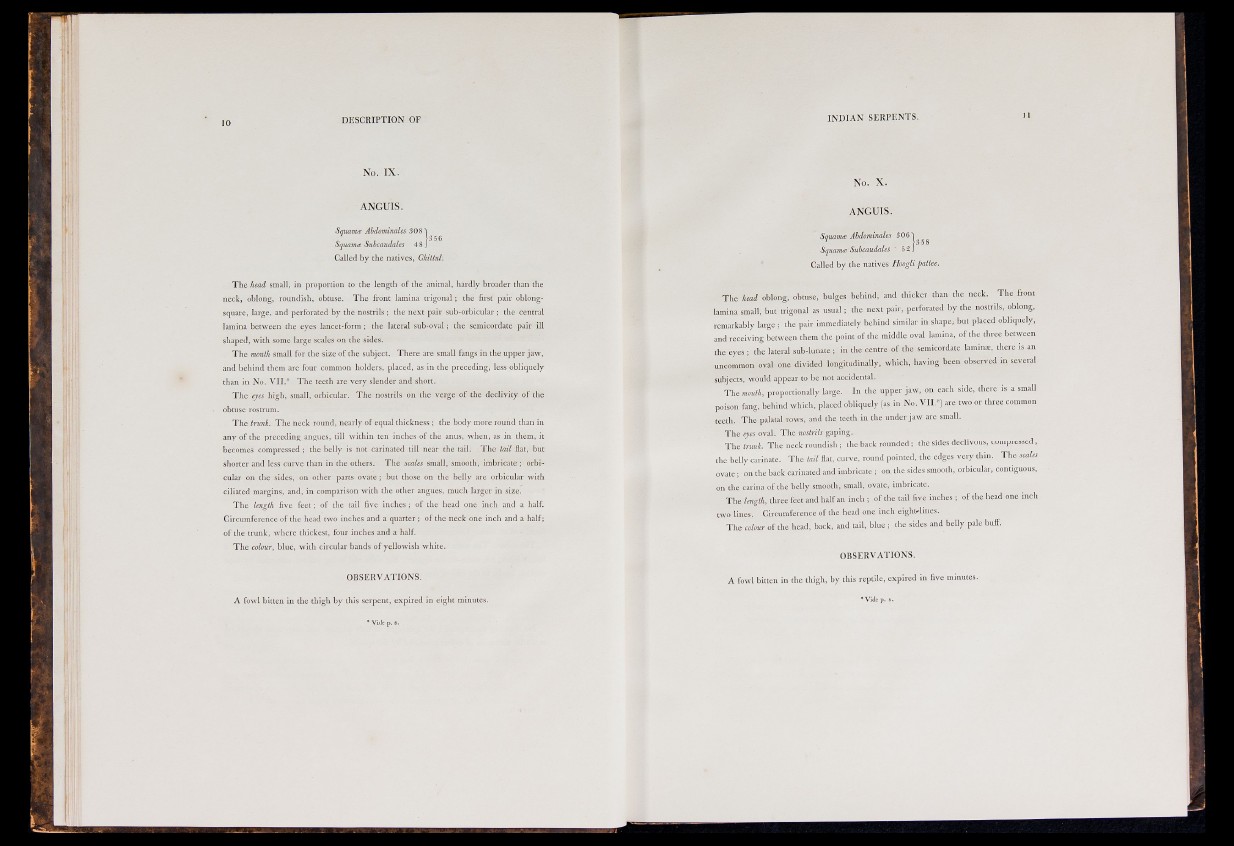
DESCRIPTION OF
No. IX.
ANGUIS.
Squamie Abdominales 308 T
Squama: Suhcaudales 48 J
Called by the natives, Chillul.
The head small, in proportion to the length of the animal, hardly broader than the
neck, oblong, roundish, obtuse. The front lamina trigonal ; the first pair oblongsquare,
large, and perforated by the nostrils ; the next pair sub-orbicular ; the central
lamina between the eyes lancet-form ; the lateral sub-oval ; the semicordate pair ill
shaped, with some large scales on the sides.
The moulli small for the size of the subject. There are small fangs in the upper jaw,
and behind them are four common holders, placed, as in the preceding, less obliquely
than in No. VII.* The teeth are very slender and short.
The eyes high, small, orbicular. The nostrils on the verge of the declivity of the
obtuse rostrum.
The trimk. The neck round, nearly of equal thickness ; the body more round than in
any of the preceding angues, till within ten inches of the anus, when, as in them, it
becomes compressed ; the belly is not carinated till near the tail. The tail flat, but
shorter and less curve than in the others. The scales small, smooth, imbricate ; orbicular
on the sides, on other parts ovate ; but those on the belly are orbicular with
ciliated margins, and, in comparison with the other angues, much larger in size.
The length five feet ; of the tail five inches ; of the head one inch and a half.
Circumference of the head two inches and a quarter ; of the neck one inch and a half;
of the trunk, where thickest, four inches and a half.
The colour, blue, with circular bands of yellowish white.
OBSERVATIONS.
A fowl bitten in the thigh by this serpent, expired in eight minutes.
•Vide p. 8.
I N D I A N SERPENTS.
No. X.
ANGUIS.
Squama Abdominales
Squama Subcaiidales ' 52 J
Called by the natives Hoogli paliee.
The head oblong, obtuse, bulges behind, and thicker than the neck. The front
lamina small, but trigonal as usual ; the next pair, perforated by the nostrils, oblong,
remarkably large ; the pair immediately behind similar in shape,- but placed obliquely,
and receiving between them the point of the middle oval lamina, of the three between
the eyes ; the lateral sub-luuate ; in the centre of the semicordate laminae, there is an
uncommon oval one divided longitudinally, which, having been observed in several
subjects, would appear to be not accidental.
The mouth, proportionally large. In the upper jaw, on each side, there is a small
poison fang, behind which, placed obliquely (as in No. V I I a r e two or three common
teeth. The palatal rows, and the teeth iu the under jaw are small.
The eyes oval. The nostrils gaping.
The trunk. The neck roundish ; the back rounded ; the sides declivous, compressed ;
the belly cannate. The tail flat, curve, round pointed, the edges very thin. The scales
ovate ; on the back carinated and imbricate ; on the sides smooth, orbicular, contiguous,
on the carina of the belly smooth, small, ovate, imbricate.
The length, three feet and half an inch ; of the tail five inches ; of the head one inch
two lines. Circumference of the head one inch eightrlines.
The colour of the head, back, and tail, blue ; the sides and belly pale buff.
OBSERVATIONS.
A fowl bitten in the thigh, by this reptile, expired in five minutes.
'Vide p. s.